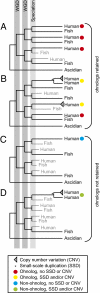Ohnologs in the human genome are dosage balanced and frequently associated with disease
- PMID: 20439718
- PMCID: PMC2889102
- DOI: 10.1073/pnas.0914697107
Ohnologs in the human genome are dosage balanced and frequently associated with disease
Abstract
About 30% of protein-coding genes in the human genome are related through two whole genome duplication (WGD) events. Although WGD is often credited with great evolutionary importance, the processes governing the retention of these genes and their biological significance remain unclear. One increasingly popular hypothesis is that dosage balance constraints are a major determinant of duplicate gene retention. We test this hypothesis and show that WGD-duplicated genes (ohnologs) have rarely experienced subsequent small-scale duplication (SSD) and are also refractory to copy number variation (CNV) in human populations and are thus likely to be sensitive to relative quantities (i.e., they are dosage-balanced). By contrast, genes that have experienced SSD in the vertebrate lineage are more likely to also display CNV. This supports the hypothesis of biased retention of dosage-balanced genes after WGD. We also show that ohnologs have a strong association with human disease. In particular, Down Syndrome (DS) caused by trisomy 21 is widely assumed to be caused by dosage effects, and 75% of previously reported candidate genes for this syndrome are ohnologs that experienced no other copy number changes. We propose the remaining dosage-balanced ohnologs on chromosome 21 as candidate DS genes. These observations clearly show a persistent resistance to dose changes in genes duplicated by WGD. Dosage balance constraints simultaneously explain duplicate gene retention and essentiality after WGD.
Conflict of interest statement
The authors declare no conflict of interest.
Figures


Comment in
-
Functional genomics: One gene or two?Nat Rev Genet. 2010 Jul;11(7):453. doi: 10.1038/nrg2816. Nat Rev Genet. 2010. PMID: 20548293 No abstract available.
References
Publication types
MeSH terms
LinkOut - more resources
Full Text Sources
Other Literature Sources
Medical
Molecular Biology Databases

